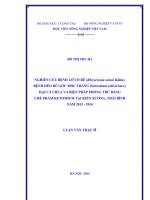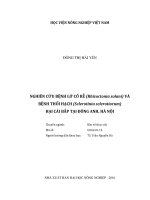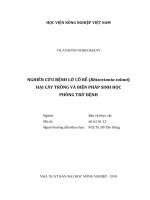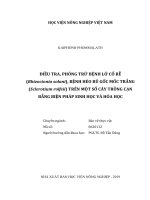tài liệu môn bệnh cây: Bệnh lở cổ rễ rhizoctonia solani 1
Bạn đang xem bản rút gọn của tài liệu. Xem và tải ngay bản đầy đủ của tài liệu tại đây (1006.34 KB, 11 trang )
Rhizoctonia solani
Pathogen profile created by Paulo Ceresini
as one of the requirements of the course PP-728 Soilborne Plant
Pathogens, offered on Spring 1999
Introduction
Rhizoctonia solani, the most widely
recognized species of Rhizoctonia was
originally described by Julius Kühn on
potato in 1858. Rhizoctonia solani is a
basidiomycete fungus that does not
produce any asexual spores (called
conidia) and only occasionally will the
fungus produce sexual spores
(basidiospores). In nature, R.
solani reproduces asexually and exists
primarily as vegetative mycelium and/or sclerotia. Unlike many
basidiomycete fungi, the basidiospores are not enclosed in a fleshy,
fruiting body or mushroom. The sexual fruiting structures and
basidiospores (i.e. teleomorph) were first observed and described in
detail by Prillieux and Delacroiz in 1891. The sexual stage of R.
solani has undergone several name changes since 1891, but is now
known as Thanatephorus cucumeris.
Host range and distribution
R. solani is a very common soilborne pathogen with a great diversity
of host plants. The Table 1 illustrates the relationship of particular
anastomosis groups of R. solani and the hosts they infect.
Isolation
Qualitative determinations of R. solani in infected plants are made by
isolations from infected host plant tissues. Infected plant tissues are
cut in pieces of 5 cm, washed in running tap water to eliminate any
attached organic debris, and blotted to dry. Small samples of plant
tissue (0.5 cm of length) are then cut from the lesions and transferred
to an isolation medium, which can be either general (e.g. alkaline
water agar) or selective (e. g. modified Ko & Hora medium). The
alkaline water agar medium provides a faster way of isolating the
fungus than other general media since successful isolation of R.
solani can be obtained after 24 h of transfer (Guttierrez et al., 1997).
Quantitative determination of R. solani from soils to estimate the
inoculum density are based on the saprophitic and/or pathogenic
competitive abilities of the fungus. Methods developed from this
principle included the burial and subsequent recovery of various
substrates as baits forRhizoctonia. The baits include suscetible host
plants, autoclaved seeds, stem segments such as flax, buckwheat,
bean, cotton and cereal straw, and even agar baits. Other methods
include different soil sieving procedures combined with selective
media for the isolation of R. solani from soil. A subsequent method
using a multiple-pellet soil-sampler was developed for quantitative
estimation of propagule density of R. solani based on placement of
weighed amounts of soil, or soil pellets on water agar supplemented
with chloramphenicol, or on selective media (Hennis et al.1978, Ko &
Hora 1971, Castro et al. 1988).
Identification
The vegetative mycelium of R.
solani and other Rhizoctonia fungi are
colorless when young but become
brown colored as they grow and
mature. The mycelium consists of
hyphae partitioned into individual cells
by a septum containing a dough-nut
shaped pore. This septal pore allows
for the movement of cytoplasm,
mitochondria, and nuclei from cell to
cell. The hyphae often branch at a 90o angles and usually possess
more than three nuclei per hyphal cell. The anatomy of the septal
pore and the cellular nuclear number (CNN) have been used
extensively by researchers to differentiate R. solani from
other Rhizoctonia fungi. R. solani[renamed Moniliopsis solani =
Moniliopsis anderholdii (Moore, 1987)] is characterized by: CNN
close to the tips in young hyphae greater than two, main runner
hyphae usually wider than 7µm, mycelium buff-colored to dark brown,
sclerotia (if present) irregular shape, light to dark brown, not
differentiated into rind and medula and having Thanatephorus
cucumeris its as teleomorph.
Because R. solani and other Rhizoctonia fungi do not produce
conidia and only rarely produce basidiospores, the classification of
these fungi often has been difficult. Prior to the 1960’s, researchers
relied mostly on differences in morphology observed by culturing the
fungus on a nutrient medium in the laboratory and/or pathogenicity
on various plant species to classify Rhizoctonia. In 1969, J. R.
Parmeter and his colleagues at the University of California in
Berkeley, reintroduced the concept of "hyphal anastomosis" to
characterize and identify Rhizoctonia. The concept implies that
isolates of Rhizoctonia that have the ability to recognize and fuse (i.e.
"anastomose") with each other are genetically related, whereas
isolates of Rhizoctonia that do not have this ability are genetically
unrelated.
Anastomosis groups of binucleate and
multinucleate Rhizoctonia spp.
Hyphal anastomosis criteria have been
used extensively to place isolates
of Rhizoctonia into taxonomically
distinct groups called anastomosis
groups. In practice, hyphal
anastomosis is determined in several
ways. The most commonly employed
practice involves pairing two isolates
of Rhizoctonia on a glass slide and
allowing them to grow together. The
area of merged hyphae is stained and examined microscopically for
the resulting hyphal interaction(s).
Pairing of isolates belonging to the same AG-results in hyphal fusion
(anastomosis), leading to either acceptance (self-pairings) or
rejection (somatic incompatibility). Pairings between AGs do not
result in hyphal fusion, suggesting greater genetic differences
between isolates (i.e., different species, etc.) Interpretation of
anastomosis reaction is not always straightforward because the four
hyphal interaction phenotypes (C0 to C3) represent a continuum.
Within an AG, two types of hyphal interactions (C2 and C3) are most
relevant for the study of population biology. The C2 reaction (also
referred as killing reaction), represents a somatic incompatibility
response between genetically distinct individuals. The C3
reaction (perfect fusion) between two isolates is indicative of genetic
identity or near identity.
Very little is known about the genetic mechanisms controlling this
recognition process in Rhizoctonia. In other filamentous
fungi, somatic incompatibility is controlled by several genes with
multiple alleles. For two fungal isolates to be compatible, all somatic
compatibility loci must be the same.
Isolates of R. solani have been assigned to 12 AGs. Recent protein
and DNA-based studies support the separation of R. solani into
genetically distinct groupings, but has also revealed considerable
genetic diversity within an anastomosis group. Hyphal anastomosis
and molecular methods are currently being used to further examine
the taxonomy, ecology and pathology of R. solani.
Symptoms
R. solani primarily attacks below
ground plant parts such as the
seeds, hypocotyls, and roots, but is
also capable of infecting above
ground plant parts (e.g. pods, fruits,
leaves and stems). The most
common symptom of Rhizoctonia
disease is referred to as "dampingoff" characterized by non germination
of severely infected seed whereas
infected seedlings can be killed either before or after they emerge
from the soil. Infected seedlings not killed by the fungus often have
cankers, which are reddish-brown lesions on stems and roots. In
addition to attacking below ground plant parts, the fungus will
occasionally infect fruit and leaf tissue located near or on the soil
surface. This type of disease often occurs because the mycelium
and/or sclerotia of the fungus are close to or splashed on the plant
tissue.
Although most Rhizoctonia diseases are initiated by mycelium and/or
sclerotia, several important disease of beans, sugar beet, and
tobacco result from basidiospore infection.These basidiospores also
serve as a source for rapid and long distance dispersal of the fungus.
The basidiospores germinate to produce hyphae that infect leaves
during periods of high relative humidity and periods of extended wet
weather. Under these conditions, basidiospores can often be
observed on the base of stems near the soil surface or on the
underside of leaves in the plant canopy.
Ecology and life cycle
R. solani can survive for many years by producing small (1 to 3-mm
diameter), irregular-shaped, brown to black structures (called
sclerotia) in soil and on plant tissue. Certain rice pathogens of R.
solani, have evolved the ability to produce sclerotia with a thick outer
layer that allows them to float and survive in water. R. solani also
survives as mycelium by colonizing soil organic matter as a
saprophyte, particularly as a result of plant pathogenic activity.
Sclerotia and/or mycelium present in soil and/or on plant tissue
germinate to produce vegetative threads (hyphae) of the fungus that
can attack a wide range of food and fiber crops.
The fungus is attracted to the plant by chemical stimulants released
by actively growing plant cells and/or decomposing plant residues. As
the attraction process proceeds, the fungal hypha will come in
contact with the plant and become attached to its external surface.
After attachment, the fungus continues to grow on the external
surface of the plant and will causes disease by producing a
specialized infection structure (either an appresorium or infection
cushion) that penetrates the plant cell and releases nutrients for
continued fungal growth and development. The infection process is
promoted by the production of many different extracellular enzymes
that degrade various components of plant cell walls (e.g. cellulose,
cutin and pectin). As the fungus kills the plant cells, the hyphae
continues to grow and colonize dead tissue, often forming sclerotia.
New inoculum is produced on or in host tissue, and a new cycle is
repeated when new substrates become available.
Links to other sites
Rhizoctonia research
Rhizoctonia Diseases on Potato
Rhizoctonia Sheath Disease Complex in Rice
Rhizoctonia Root Rot on Wheat
Rhizoctonia Diseases on Lettuce
Dry bean diseases
Availability of germplasm for resistance against Rhizoctonia
spp. (USDA)
Rhizoctonia on corn
Acknowledgements
We acknowledge Drs. Marc Cubeta, David Shew and Gloria Abad for
supplying us with a series of slides to illustrate the host range of R.
solani. Special thanks also for Heather Hartzog for drawing the life
cycle of the pathogen.
Selected references
Adam, G. C. 1988. Thanatephorus cucumeris (Rhizoctonia
solani) a species of wide host range. In Advances in Plant
Pathology, Vol. 6. Genetics of Plant Pathogenic Fungi.
(G.S. Sidhu, ed.), pp. 535-552. Academic Press, New York.
Agrios, G. N. 1997. Plant Pathology. 4th Ed., 606 pp.
Academic Press, New York.
Alexopoulos, C. J., Mims, C. W. and Blackwell, M.
1996. Introductory Mycology., 4th Ed., 869 pp., John Wiley
and Sons, New York.
Anderson, N.A. 1982. The genetics and pathology
of Rhizoctonia solani. Ann. Rev. Phytopathol. 20:329-347
Castro, C., Davis, J. R., and Wiese, M.V. 1988. Quantitative
estimation of Rhizoctonia solani AG-3 in soil. Phytopathology
78:1287-1292.
Cubeta, M.A., and R. Vilgalys. 1997. Population biology of
the Rhizoctonia solani complex. Phytopathology 87:480-484.
Guttierez, W.A., H.D. Shew, and T. A. Melton. 1997. Sources
of inoculum and management for Rhizoctonia solani dampingoff on tobacco transplants under greenhouse conditions. Plant
Disease 81:604-606.
Hawksworth, D. L., Kirk, P. M., Sutton, B. C., and Pegler, D.
N. 1995. Ainsworth and Bisby’s, Dictionary of the Fungi.
8th Ed., 616 pp. University Press, Cambridge, UK.
Hennis, Y., Ghafar, A., Baker, R. and Gillespie, S.L. 1978. A
new pellet soil sampler and its use for the study of population
dynamics of Rhizoctonia solani in soil. Phytopathology 68: 371376
Ko, W. H., and Hora, F. K. 1971. A selective medium for the
quantitative determination of Rhizoctonia solani in soil.
Phytopathology 61:707
Ogoshi, A. 1987. Ecology and pathogenicity of anastomosis
and intraspecific groups of Rhizoctonia solani Kühn. Ann. Rev.
Phytopathol. 25:125-143.
Sneh, B., Burpee, L., and Ogoshi, A. 1991. Identification
of Rhizoctonia species.133pp. APS Press, St. Paul, MN,
USA.
Sneh, B., Jabaji-Hare, S., Neate, S. and Dijst, G.
1996. Rhizoctonia species: Taxonomy, Molecular Biology,
Ecology, Pathology, and Control, 578 pp. Kluwer Academic
Publishers, Dordrecht, The Netherlands.
Vilgalys, R., and M. A. Cubeta. 1994. Molecular systematics
and population biology of Rhizoctonia. Annu. Rev. Phytopathol.
32:135-155
Table 1. Host range of Rhizoctonia
solani and Rhizoctonia diseases arranged by anastomosis
groups (based on Sneh et al., 1991).
Anastomosis
group
Diseases
AG 1-IA
Host
‘sheath blight’,
‘sheath spot’
rice
‘sclerotial disease’, ‘leaf blight’,
‘banded leaf’
corn
‘leaf blight’, ‘banded leaf’
sorghum
‘leaf blight’
bean
‘leaf blight’
soybean
‘summer blight’
crimson clover
‘southern blight’
camphor seedlings
‘brown patch’
turfgrass
AG 1-IB
‘web blight’
bean
rice
soybean
figs
leguminosous woody plants
hortensia
‘rot’
cabbage
'bottom rot’
AG 1-IC
‘damping off’'
lettuce
buckwheat
'damping off and
crown root rot'
carrot
‘damping off’'
soybean
flax
pine
AG 2-1
‘damping off’
crucifers
‘bud rot’
strawberry
‘leaf blight’
tulip
‘root rot’
Japanese radish and
subterranean clover
AG 2-2 IIIB
‘false sheath blight’
rice
‘sheath blight’
mat rush
ginger
gladiolos
‘black scurf’
‘brown patch’
edible burdock
turf grass
‘crown and brace rot’
corn
‘damping off’
sugar beet
tree seedlings
crhysanthemum
‘root rot’
konjak
chinese yam
AG 2-2 IV
‘root rot’ and ‘leaf blight’
sugar beet
‘large patch’
turfgrass
AG 3
AG 4 (HG I, HGII
and HGIII)
‘black scurf’ and
‘stem/stolon cankers’
potatoes
'target spot’ (slide 01, slide
02,slide 03, slide 04, slide 05 )
tobacco
‘leaf blight
tomato
‘brown spot’
egg plant
‘fruit rot’
tomato
‘stem rot’
pea
‘damping off ‘ and ‘stem canker’
potato
‘damping off’ and
‘root rots’
soybean
lobolly pine seedlings
onion
stevia
pea
snap bean
cotton
peanuts
slash
'pod rot'
AG 5
snap bean
‘black scurf’
potato
‘brown patch’
turf grass
‘root rot’
beans
soybeans
adzuki beans
AG 6
nonpathogenic group
-
AG 7
nonpathogenic
-
AG 8
‘bare patches’
cereals
AG 9
weak pathogen
crucifers
potatoes
AG 10
AG 11
nonpathogenic
wheat
AG BI
nonpathogenic
-
Table 2. Modified Ko and Hora medium (Hennis et al. 1978, Ko &
Hora 1971, Castro et al. 1988).
Components
Active
ingredient (g)
K2HPO4
1
MgSO4.7H2O
0.5
KCl
0.5
FeSO4. 7H2O
0.01
NaNO2
0.2
chloramphenicol
0.05
agar
20
destiled water
1000
After sterilization in autoclave at 121oC/20 min, wait until the medium cool down to 50 oC,
then add:
Components
Active
Comercial
ingredient (g) product (g)
galic acid
0.4
streptomycin
0.05
metalaxyl (Ridomil 2E: 25%)
0.0633
0.2532
prochloraz (Prochloraz 38.1%)
0.005
0.0131
Return to R. solani home page.




